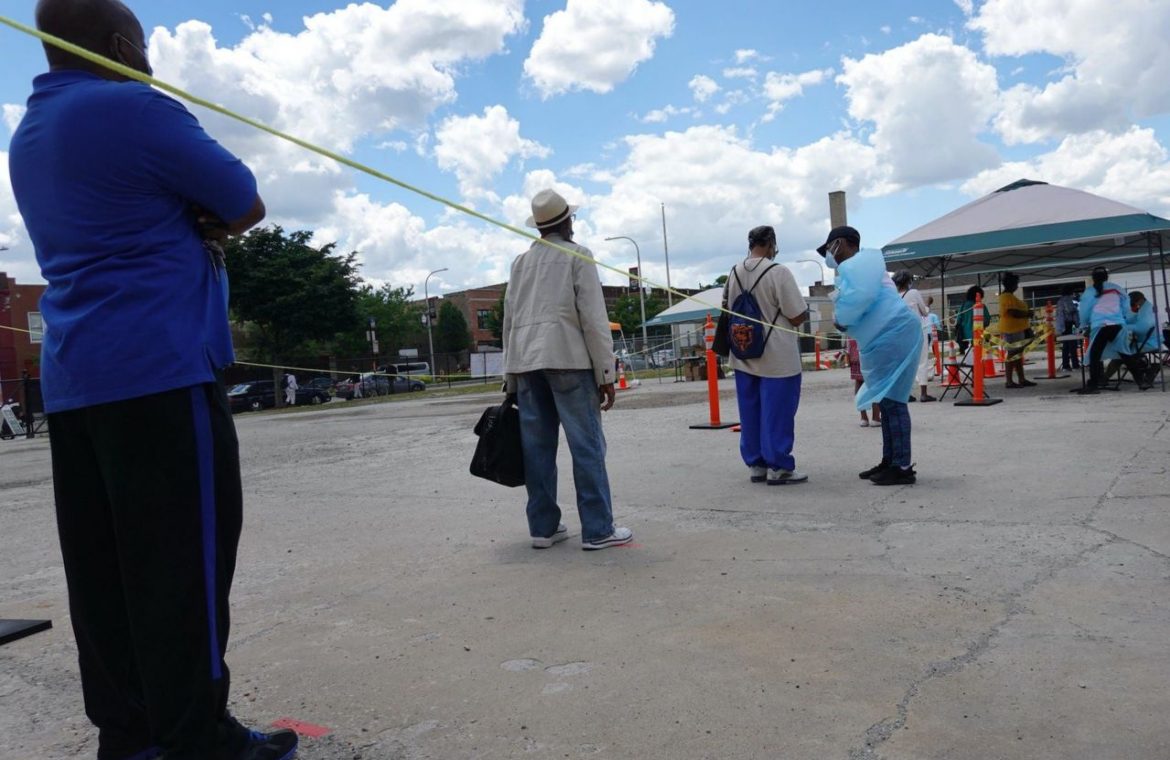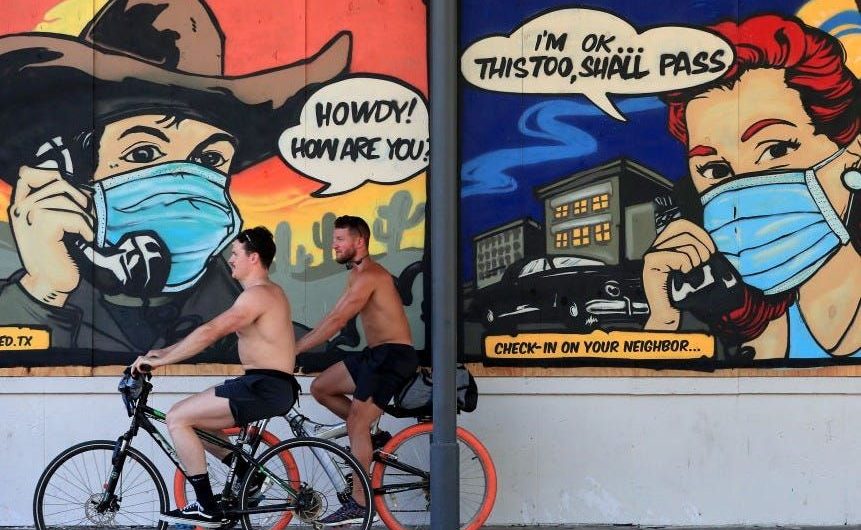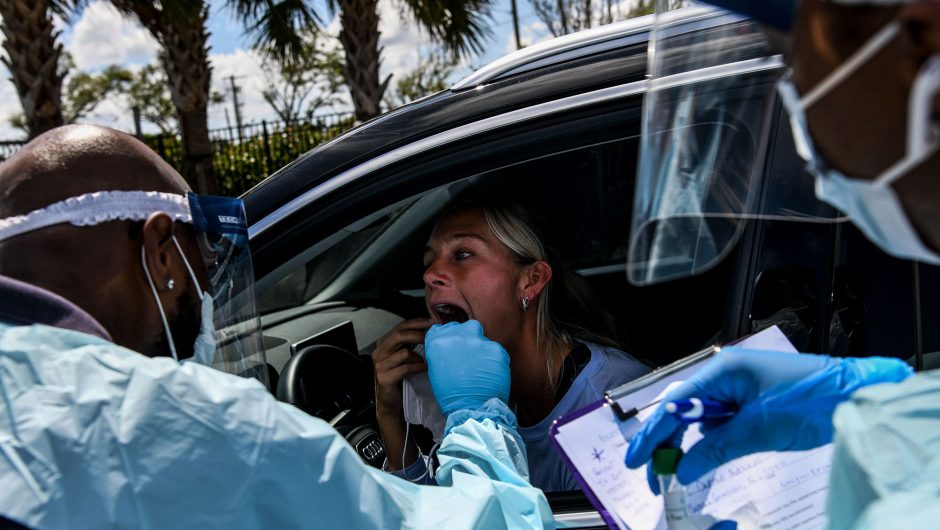Residents wait in line at a mobile COVID-19 testing site set up in a vacant lot in Chicago, Illinois, on June 23, 2020.
Scott Olson/Getty Images
State officials around the US are scrambling to deal with a surge in coronavirus cases, while the federal government is poised to end support and funding for 13 testing sites.
The screening locations are in Texas, New Jersey, Illinois, Colorado, and Pennsylvania, TPM first reported.
This decision could “have catastrophic cascading consequences” when it comes to identifying and isolating new cases, Dr. David Persse of the Houston Health Department wrote in a letter to the deputy surgeon general.
Experts told Business Insider that frequent and widespread testing is crucial because the coronavirus is still in our midst and can easily overwhelm the nation’s already strained healthcare system.
Visit Business Insider’s homepage for more stories.
Coronavirus cases are spiking across a broad swath of the American South and West.
But the Trump administration is slated to discontinue funding for 13 federal testing sites across five states, starting at the end of June, Talking Points Memo revealed on Tuesday.
This move comes following President Donald Trump’s comments last week at a roundtable for seniors in which he argued that “if we stop testing right now, we’d have very few cases, actually.”
He employed similar rhetoric on Saturday at a rally in Tulsa in which he complained that the country’s caseload is up due to an overall increase in the availability of coronavirus tests. He touted responding to the surging pandemic by telling his team to “slow the testing down please.”
Trump has been promoting this flawed logic for the past month.
In May, he told Iowa Gov. Kim Reynolds, “So the media likes to say we have the most cases, but we do, by far, the most testing. If we did very little testing, we wouldn’t have the most cases. So in a way, by doing all of this testing, we make ourselves look bad.”
Seven of the sites slated for defunding are in Texas, which just this week reported record-high hospitalization rates for 10 consecutive days and an upward trend in new infections. New Jersey and Illinois each have two facilities, and Colorado and Pennsylvania both have one, according to TPM. Colorado is the only state that’s not on the list of 10 worst-hit states in the US.
Story continues
Despite the administration’s decision to stop providing federal support for these sites, some states are securing funding to keep them open. New Jersey’s Gov. Phil Murphy announced to reporters on Tuesday that he has “secured continued assistance” from the Federal Emergency Management Agency (FEMA) and the Department of Health and Human Services for both the state’s screening locations.
“This partnership among state, federal government and our pharmacy chains, which has led to a significant increase in community-based testing centers, and which had also been scheduled to end on June 30th will now continue through at least the end of August. I am grateful for this partnership and that it will continue,” Murphy said.
Loss of federal support can trigger ‘catastrophic cascading consequences’
Officials in other states weren’t as lucky.
“Illinois did request an extension for continued federal support at the two Illinois community-based testing sites the federal government was funding, but unfortunately, the request was denied,” Melaney Arnold, a public information officer for the Illinois Department of Public Health, told Business Insider in an email.
The onus is now on the state to bolster testing efforts and officials plan to “continue to support these sites,” she added.
A woman takes a COVID-19 test on June 20, 2020 in Livingston, Montana.
William Campbell/Getty Images
In Pennsylvania, a testing site at Montgomery County Community College has been affected.
Officials are in the “planning stages of setting up six walk-up testing locations around the county” so residents can continue to be screened for the coronavirus. The new facilities are “being paid for with CARES Act funding,” county spokeswoman Teresa Harris told Business Insider.
Officials in Texas, too, have requested an extension and are awaiting a reply.
The county, is experiencing “a nearly four-fold increase in hospital admission not only within hospitals in the city but across Harris County since May 21st,” Dr. David Persse, public health authority for the Houston Health Department, wrote in a letter to the Surgeon General’s office.
“Losing the support of the Federal government for testing sites will undoubtedly have catastrophic cascading consequences in the region’s ability to adequately test, quarantine, and isolate” new patients, which is necessary to curb the transmission of the highly contagious illness, he wrote.
In Houston alone, the two FEMA-operated sites have helped screen an estimated 60,000 people, Scott Packard, the Houston Health Department’s chief communications officer, told Business Insider. But with the federal government poised to back away next Tuesday, local officials and agencies will assume the responsibility of screening residents at Butler and Delmar stadiums, Packard said.
Experts are anxious about decisions ‘that will reduce testing in any way during this critical time’
Dr. Melissa DuPont-Reyes, assistant professor of epidemiology and biostatistics at Texas A&M University’s School of Public Health, told Business Insider an effective response to an infectious disease outbreak hinges on early and widespread testing.
“Testing helps to mitigate the spread of COVID-19 and allows for epidemiological and scientific efforts to continue to track and understand the pandemic,” she said.
Testing is particularly important when it comes to the coronavirus because people who don’t fall sick or display symptoms can still be asymptomatic carriers who are spreading the disease to others they come in contact with.
“We cannot estimate prevalence or spread without testing,” DuPont-Reyes said.
Testing has also proven to be critical because the transmission of the coronavirus has been “dynamic over space and time with human movement and physical closeness,” she added.
“Epicenters have moved from one part of the country to another. Cases have been reported in each state, in rural, suburban, and urban areas alike. The virus does not discriminate, so it is essential to continue to provide testing everywhere,” DuPont-Reyes said.
A Florida resident gets tested for the coronavirus on April 30, 2020. Florida is among 19 states that hasn’t met testing standards set by the federal government or Harvard.
David Santiago/Miami Herald/Tribune News Service via Getty
And it’s for these reasons that Dr. Laura Rasmussen-Torvik, the epidemiology chief at Northwestern University Feinberg School of Medicine, is worried by recent steps taken by the Trump administration.
“I’m tremendously concerned about any action that will reduce testing in any way during this critical time in the pandemic,” she told Business Insider. “I’m even more concerned about actions that might reduce testing in racial and ethnic minorities, as these groups have been disproportionately impacted by the pandemic and, in some cases, these groups may have less access to testing through the traditional health care system.”
As it is, Rasmussen-Torvik said, policies have varied so drastically among states and even municipalities that some parts of the US are seeing a rapid increase in coronavirus cases, while the infection’s rate of spread is staying stable or declining in others.
The “increased numbers of positive cases and high utilization of hospital beds and ICU resources” in states like Texas and Arizona are disturbing, Rasmussen-Torvik said, because it’s possible that area hospitals could “soon be overwhelmed with COVID cases, which will lead to lower quality of care for those with COVID as well as those with other health conditions.”
However, no one would be aware of these trends without testing, DuPont-Reyes added.
“If we don’t continue testing and managing the spread of infection, it is possible to exceed the capacity of our healthcare system still, which has already been stretched thin. Healthcare workers are burned out and resources are running low,” she said.
Read the original article on Business Insider








